
copyright © Wartime Heritage Association 2012-2024
Website hosting courtesy of Register.com - a web.com company
Wartime Heritage
ASSOCIATION
Remembering World War II
Name:
Paul Martin Deveau
Rank:
Fireman Second Class
Service Number:
7616488
Service:
USS Turner (DD-648), US Navy
Date of Birth:
August 19, 1923
Place of Birth:
Boston, Massachusetts
Date of Enlistment:
December 15, 1942
Place of Enlistment:
Boston, Massachusetts
Address at Enlistment:
Walnut Street Court, Quincy,
Boston, Massachusetts
Age at Enlistment:
19
Occupation:
Rigger, Bethlehem-Hingham shipyard
Marital Status:
Single
Next of Kin:
Frank Deveau, father
Date of Death:
January 3, 1944
Age:
20
Cemetery:
East Coast Memorial, Battery Park, Manhattan, New York, NY
Grave:
No known grave, on the Tablets of the Missing
Paul Mandé ‘Martin’ Deveau was the son of Francois ‘Frank’ Nelson Deveau (1893–1946) and Agatha Marie
(Comeau) Deveau (1889–1957). Paul’s father also served in the US Navy. His father was born in Lynn, Mass.,
his mother, in Digby County, Nova Scotia.
Paul had seven siblings – Laura Marie Deveau Finch (1915–2003), Beatrice M Deveau Felaccio (1917–2005),
Florence Rita Deveau Luisi (1920–1997), Nelson Joseph Deveau (1924–2016), Ernest Thomas Deveau
(1927–1974), Eileen Patricia Deveau Mayhew (1929–2012), and Richard Joseph Deveau (1930–1987). Three
of Francis’ brothers, Nelson, Ernest, and Richard all served in United States Air Force.
The family lived on Sea Avenue in Quincy, Boston, Massachusetts in 1930. In 1940, they were living 7 Walnut
Street Court in Quincy. By 1942, his parents had moved to 56 Bird Street in Quincy, and Paul was employed
as a rigger at the Bethlehem-Hingham Shipyard.
After enlisting in December of 1942, Paul was
assigned to the USS Turner, a Gleaves-class
destroyer. He transferred from R/S Long
Beach, New York, to the USS Turner on April
15, 1943, the day the Turner was
commissioned.
On August 31, 1943, he was promoted from
Seaman 2nd Class to Fireman 2nd Class.
The Turner completed outfitting at the New
York Navy Yard and then conducted
shakedown and antisubmarine warfare
training out of Casco Bay, Maine, until early
June. On the 9th, she returned to New York to prepare for her first assignment, a three-day training cruise
with the newly commissioned carrier, Bunker Hill (CV-17). Returning to New York on June 22nd, she
departed again the next day on her first real wartime assignment, service in the screen of a transatlantic
convoy. First, she sailed with a portion of that convoy to Norfolk, Va., arriving that same day. On the 24th,
the convoy departed Hampton Roads and shaped a course eastward across the Atlantic. After an uneventful
voyage, she escorted her convoy into port at Casablanca, French Morocco, on July 18th. She departed with a
return convoy on the 23rd and arrived back in New York on August 9, 1943. Later that month, she was in the
screen of a convoy to Guantanamo Bay, Cuba, making a brief stop at Hampton Roads along the way. On the
return trip, she rendezvoused with HMS Victorious and accompanied the British carrier to Norfolk.
During the first 2 weeks of September, Turner conducted ASW training at Casco Bay, Maine, and then
returned to New York to prepare for her second transatlantic voyage. On 21 September, the destroyer
headed south to Norfolk. She arrived there on the 23rd and, the following day, headed out across the
Atlantic with her convoy. After an 18-day passage, during which she made one depth-charge attack on a
sound contact, Turner arrived at Casablanca on October 12th. Four days later, she departed again and
headed for Gibraltar to join another convoy. The warship reached the strategic base on the 17th and, after
two days in port, stood out to join the screen of Convoy GUS-18.
On the night of October 23rd, Turner was acting as an advance ASW
escort for the convoy when she picked up an unidentified surface
contact on her SG radar. At 1943, about 11 minutes after the initial
radar contact, Turner's lookouts made visual contact with what
proved to be a German submarine running on the surface, decks
awash, at about 500 yards distance. Almost simultaneously, Turner
came hard left and opened fire with her 6-inch, 40-millimeter, and
20-millimeter guns. During the next few seconds, the destroyer
scored one 6-inch hit on the U-boat's conning tower as well as
several 40-millimeter and 20-millimeter hits there and elsewhere.
The submarine began to dive immediately and deprived Turner of
any opportunity to ram her. However, while the U-boat made her
dive, Turner began a depth-charge attack. She fired two charges
from her port K-gun battery, and both appeared to hit the water
just above the submerged U-boat. Then, as the destroyer swung around above the U-boat, Turner rolled a
single depth charge off her stern. Soon after the 3 depth charges exploded, Turner crewmen heard a fourth
explosion, the shock from which caused the destroyer to lose power to her SG and FD radars, to the main
battery, and to her sound gear. It took the crew at least 15 minutes to restore power entirely.
Meanwhile, Turner began a search for evidence to corroborate a sinking or regain contact with the target. At
about 20:17, she picked up another contact on the SG radar - located about 1,600 yards off the port beam.
Turner came left and headed toward the contact. Not long thereafter, her bridge watch sighted an object
lying low in the water. Those witnesses definitely identified the object as a submarine which appeared to be
sinking by the stern. Unfortunately, Turner had to break contact with the object in order to avoid a collision
with another of the convoy's escorts. By the time she was able to resume her search, the object had
disappeared. Turner and Sturtevant (DE-239) remained in the area and conducted further searches for the
submarine or for proof of her sinking but failed in both instances. All that can be said is that probably the
destroyer heavily damaged an enemy submarine and may have sunk her. No conclusive evidence exists to
support the latter conclusion.
The next day on October 24th, the 2 escorts rejoined the convoy, and the crossing continued peacefully.
When the convoy divided itself into two segments according to destination on November 4, 1943, Turner
took station as one of the escorts for the Norfolk-bound portion. Two days later, Turner saw its charges
safely into port and then departed to return to New York where she arrived on November 7th.
Following 10 days in port, the warship conducted anti-submarine warfare exercises briefly at Casco Bay
before returning to Norfolk to join another transatlantic convoy. She departed Norfolk with her third and
final convoy on November 23rd and saw the convoy safely across the Atlantic. On January 1, 1944, near the
end of the return voyage, that convoy split into two parts according to destination as Turner's previous one
had done. Turner joined the New York-bound contingent and shaped a course for that port. She arrived off
Ambrose Light late on 2 January and anchored, having completed three convoys to Europe.
Early the following morning, January 3rd, the destroyer suffered a series of shattering internal explosions.
By 06:50, the ship took on a 16° starboard list; and explosions, mostly in the ammunition stowage areas,
continued to stagger the stricken destroyer. Then, at about 07:50, a singularly violent explosion caused the
ship to capsize and sink. The tip of the USS Turner’s bow remained above water until about 08:27 when it
disappeared completely taking with it 15 officers and 123 men.
Paul Martin Deveau has no know grave and is remembered on the Tablets of the Missing on the East Coast
Memorial situated in Battery Park in in Manhattan, New York, NY.
Over the next year following the loss of the USS Turner, the US Navy completed salvage operations on the
sunk vessel and in the end all that remained was part of one boiler. But during the salvage, human remains
were found and placed in four separate graves in the Long Island National Cemetery. Exactly how many
bodies are in those four graves is unknown. It would range from four to all 138 casualties of the loss of the
Turner.
A second sailor, Gunner's Mate Third Class Edward Louis Lambert, was born in Margaree Forks, Nova Scotia,
and died in the second explosion on the USS Turner, attempting to assist the Turner and its crew.
Paul Martin Deveau


Sources
Photo: Courtesy of Timothy A. Byrnes
U.S., World War II Navy Muster Rolls, 1938-1949
American Battle Monuments Commission – Paul M. Deveau
American Battle Monuments Commission – East Coast Memorial
USS Turner
findagrave
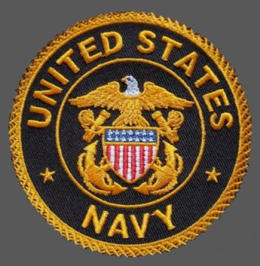
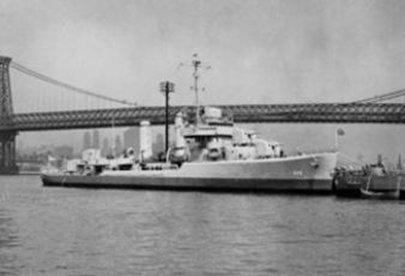
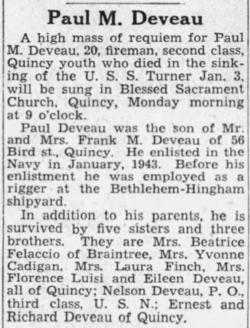
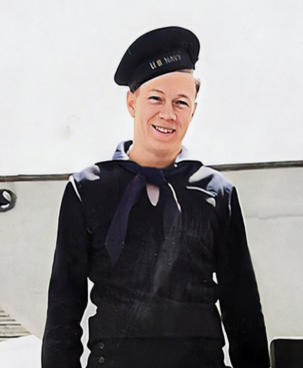
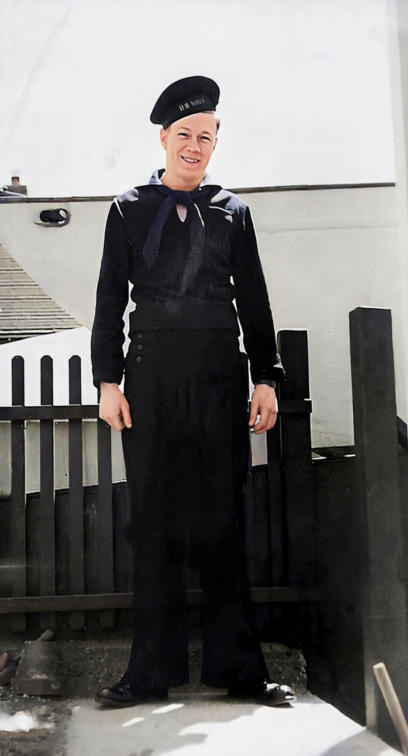
Photo of Paul was taken by his cousin Doris Deveau at her
home on City Island, Bronx, New York while his ship was in
port.


- World War I - Menu
- WWI Stories and Articles
- Photos - Yarmouth Soldiers
- Selection of World War I Songs
- WWI Casualties of Yarmouth, NS
- Those Who Served - Yarmouth, NS
- WWI Casualties Digby Co. NS
- WWI Casualties Shelburne Co. NS
- Merchant Mariners (1915) Yarmouth, NS
- Canadian Forestry Corps - Non Yarmouth Birth/Residence Enlistments
- US Draft Registry - Yarmouth NS Born


- World War II - Menu
- WWII Stories and Articles
- Telegraphist Air Gunners
- WWII Casualties of Nova Scotia
- US Casualties with NS Connection
- Far East/Pacific Casualties with NS Connection
- Merchant Navy Casualties Nova Scotia
- Nova Scotia WWII Casualties Holten Canadian War Cemetery
- D-Day Casualties - Nova Scotia
- CANLOAN Program Casulaties - Nova Scotia
- Battle of the Bulge Casualties - Nova Scotia
- WWII Casualties Yarmouth NS
- Yarmouth Casualties - RCAF RAF Canadian Army WWII
- Yarmouth Co., Marrages WWII
- Casualties Non-Born/Residents with Connection to Yarmouth Co., Nova Scotia.
- WWII Casualties Digby Co., NS
- Non-Nova Scotian WWII Casualties Buried in Nova Scotia
- WWII RCAF Casualties Aged 16-18
- Brothers/Sisters Who Served - World War II













